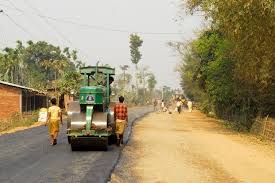GOPALPUR, India—In the world’s fastest-growing major economy, factories are running below capacity and companies aren’t spending. Exports are plummeting. Construction activity in the big cities has stalled.
Propelling Tarapada Kabiraj’s backyard yogurt business in eastern India is something humbler: paved roads.
Now that buyers from far and wide can easily drive trucks into this town of 7,000 people, his sales are booming. Until recently, he had to carry his yogurt to market in clay pots on his shoulders.
Mr. Kabiraj, 50 years old, labored in rice fields for most of his adult life. He remembers days when his family would eat just once, if at all. Now, he says, “at least we can eat three meals a day.”
India—long held back by its potholed roadways, dilapidated bridges and shaky power grid—is on a building spree. The government spent $11 billion laying 3,700 miles of highways in the latest financial year, 36% more than the year before.
Its target for this year: 9,300 miles. It also aims to commission highway projects totaling 15,500 miles before next April, and to spend $33 billion, or 11% of the budget, on infrastructure, mostly roads and railways.
Prime Minister Narendra Modi is betting a burst of public expenditure can jolt more Indian companies into spending, too. Corporations’ investments in buildings, equipment and plants have tumbled for years even though overall economic expansion, fueled by consumer activity, has quickened to a world-beating 7.6%.
The infrastructure push is also accelerating a quiet transformation in the country’s vast rural interior. As remote villages have become better-connected to the wider world, fewer Indians are working the land. More are starting shops, household industries, small-time service businesses—sources of livelihood that don’t whipsaw with the monsoon rains.
Around 43% of rural families supported themselves this way in 2010, according to a government survey, up significantly from 1994, when the figure was 32%. The trend is borne out in other more-recent data.
Places like Gopalpur “are at the hub of the big changes happening in India,” said Neelkanth Mishra, a Credit Suisse strategist in Mumbai.
The Modi administration’s success at extending nuts-and-bolts infrastructure stands apart from its other, more-fitful efforts to invigorate the economy. Opposition parties in Parliament have blocked overhauls of land and tax laws. Labor unions have fought plans to modernize state-run companies and the national rail system.
Building roads is, to some degree, a less politically thorny way of effecting change. And with trade and global demand foundering, India will need to generate momentum internally to sustain its recent economic pace.
“We have every reason to be optimistic, because there’s plenty of slack,” said Bibek Debroy, an economist at Niti Aayog, a government think tank.
Since 2000, the government has spent $21 billion building or improving 290,000 miles of local roads, connecting 110,000 settlements in jungles and on mountainsides. New towns have sprouted up so quickly in the countryside that many are still officially classified as villages, even though they are more densely populated and less farming-dependent. Between the 2001 and 2011 censuses, India produced 2,500 such towns—one nearly every working day.
These places aren’t middle-class. Schools and health centers can be woeful. But signs point to a groundswell of activity there.
Makers of consumer staples are reaching deep into the hinterland to find new buyers, even after a two-year drought that has crippled farm output. Demand for cement is brisk, despite stagnant construction in India’s largest cities—where 16% of prime office space is vacant—suggesting small-home construction is the driver.
“It is not fireworks,” said Partha Mukhopadhyay, of the Centre for Policy Research in New Delhi. “It is the product of a lot of small things.”
A dirt track used to be all that linked Gopalpur, in West Bengal state near the Bangladesh border, to the nearest major town. It turned to mud in the slightest rain, preventing local pond-fishermen from bringing their catch to markets to the north.
They and the yogurt makers benefited from the road-building that started around 2011. Today, entrepreneurs are buying electric rickshaws to move goods and passengers. Streetlights are being strung up. There is even talk, among some homeowners, of a once-unimaginable luxury: air conditioning.
“Gopalpur will look like any other city one day,” said village chief Asit Choudhury.
Incomes have grown so much, says shopkeeper Sanjay Das, that fewer people are bothering to get their televisions and cellphones repaired at his tiny store.
“If something costs 300 rupees to fix and a new one costs 800 rupees, then they’ll just buy the new one,” Mr. Das lamented.
In Arjunpur, 60 miles to the south, farming hasn’t been viable for decades. A dam built on the Ganges diverted the great river’s course, sending it closer and closer to the town until eventually it washed away the rice and jute fields.
Many of the town’s men scrounge for work in faraway cities. Their wives sit at home rolling beedis, the thin, leaf-wrapped cigarettes favored by the poor. They earn $1.80 for every 1,000 they roll—a whole day’s work even for the most nimble-fingered.
Still, ever since the cratered main road was redone a year and a half ago, Arjunpur’s transformation into a commercial hub has gathered pace.
In the town’s outdoor market, the din of the morning crowd is matched only by the horn blasts of passing cargo trucks. People come from out of town just to shop here. They are buying pricier items than they used to: shampoo, deodorant, baby food, diapers.
More-fashionable clothes, too, says Sahadat Hossain. He recently added a second room to his garment store.
“Ten years ago, a style would last for two to three years,” he said. “Now the trends are changing every season.”
source:Wall street Journals






